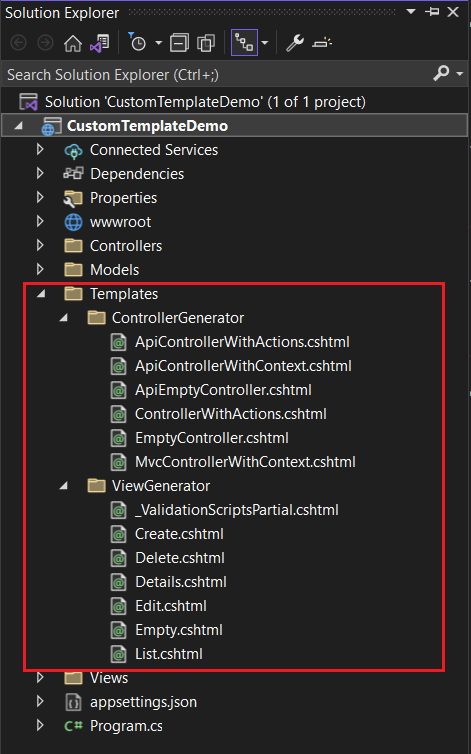Custom scaffold templates in ASP.NET Core
July 20, 2022 by Anuraj
AspNetCore VisualStudio
This post is about customizing the scaffold templates controllers and views in ASP.NET Core. We can achieve this by simply modifying the templates in this folder - %USERPROFILE%\.nuget\packages\microsoft.visualstudio.web.codegenerators.mvc\6.0.6\Templates (the number 6.0.6 will change based on the SDK version) - but if we modify the template files in this folder it will impact the whole system and we can’t share the templates with other developers. So we can create a folder with name Templates in the ASP.NET Core MVC project - while scaffolding, Visual Studio and dotnet-aspnet-codegenerator global tool will first check this folder in your project and if it is available it will use the templates from this folder.
For this demo I am using customizing Controllers and Views. To do this first we will create a project in Visual Studio or from command line. Next we need to create a folder with name Templates in the project root. And copy the ControllerGenerator and ViewGenerator folders from %USERPROFILE%\.nuget\packages\microsoft.visualstudio.web.codegenerators.mvc\6.0.6\Templates location.

Next I modified EmptyController.cshtml and I added two more action methods, like this.
@inherits Microsoft.VisualStudio.Web.CodeGeneration.Templating.RazorTemplateBase
using System;
using System.Collections.Generic;
using System.Linq;
using System.Threading.Tasks;
using Microsoft.AspNetCore.Mvc;
namespace @Model.NamespaceName
{
public class @Model.ClassName : Controller
{
public IActionResult Index()
{
return View();
}
public IActionResult About()
{
return View();
}
public IActionResult Custom()
{
return View();
}
}
}Due to some issues with the latest .NET Core release / VS 2022 release the Add New Item dialog is not working with this approach. If you’re using an old version of Visual Studio this will work. So I am using the dotnet-aspnet-codegenerator global tool to generate the controller / view. To use this, we need to install this tool first - using this command - dotnet tool install -g dotnet-aspnet-codegenerator and next we need to add reference of Microsoft.VisualStudio.Web.CodeGeneration.Design nuget package to the project using the command - dotnet add package Microsoft.VisualStudio.Web.CodeGeneration.Design.
Now we can scaffold the controller using the command dotnet-aspnet-codegenerator controller -name ExampleController -outDir Controllers --no-build - if you notice, I included --no-build flag otherwise the command will fail sometimes. If you want to avoid including this flag, you can exclude the Templates folder by right clicking on the folder and choose Exclude from Project if you’re using Visual Studio. Or we can modify the project file like this.
<Project Sdk="Microsoft.NET.Sdk.Web">
<PropertyGroup>
<TargetFramework>net6.0</TargetFramework>
<Nullable>enable</Nullable>
<ImplicitUsings>enable</ImplicitUsings>
</PropertyGroup>
<ItemGroup>
<Compile Remove="Templates\**" />
<Content Remove="Templates\**" />
<EmbeddedResource Remove="Templates\**" />
<None Remove="Templates\**" />
</ItemGroup>
<ItemGroup>
<PackageReference Include="Microsoft.VisualStudio.Web.CodeGeneration.Design" Version="6.0.7" />
</ItemGroup>
</Project>This will generate a controller with name ExampleController with the following content.
using System;
using System.Collections.Generic;
using System.Linq;
using System.Threading.Tasks;
using Microsoft.AspNetCore.Mvc;
namespace CustomTemplateDemo.Controllers
{
public class ExampleController : Controller
{
public IActionResult Index()
{
return View();
}
public IActionResult About()
{
return View();
}
public IActionResult Custom()
{
return View();
}
}
}We can use the same approach for Views as well. Here is an example of .NET Core scaffold templates for web application with MVC and RazorPages - Scaffold Templates for UI for ASP.NET Core by telerik.
Happy Programming :)
Copyright © 2024 Anuraj. Blog content licensed under the Creative Commons CC BY 2.5 | Unless otherwise stated or granted, code samples licensed under the MIT license. This is a personal blog. The opinions expressed here represent my own and not those of my employer. Powered by Jekyll. Hosted with ❤ by GitHub